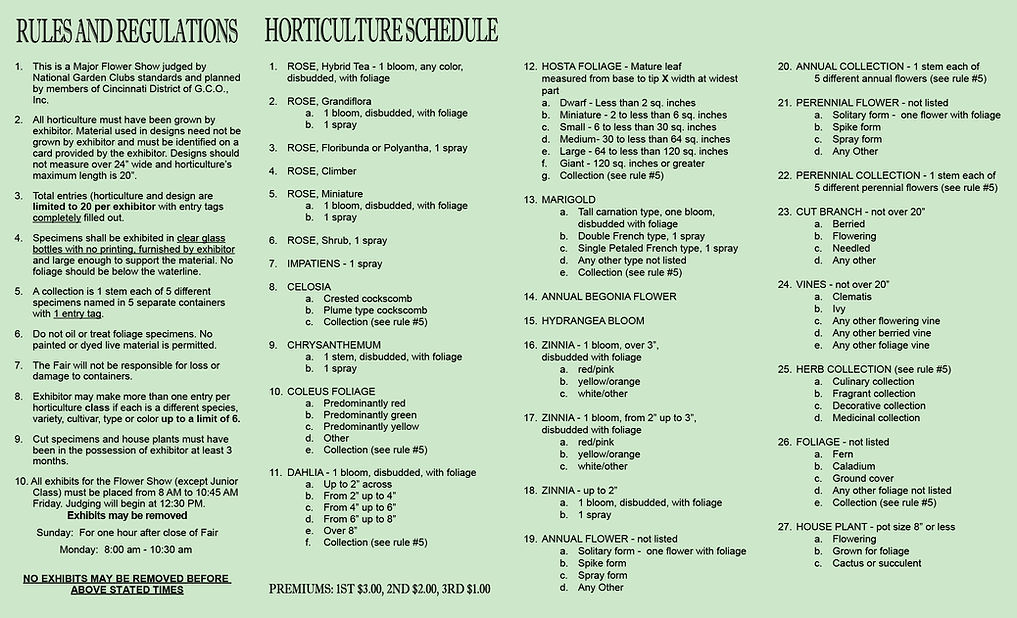Exhibits may be removed Sunday for one hour after the close of the fair, or Monday 8:00 a.m. to 10:30 a.m. with your claim check. No exhibits may be removed before the above stated time.
Flower Show Committee
Harvest Home Fair Assoc. Chair
Stefanie Hawk
Co-Chair NEEDED (email if interested)
Design Chair
Jeri Timon
of Judges Study Class
Horticulture Chair
Nancy Fenton
of Western Hills Garden Club
Garden Club Invitational Chair
Donna Cefalu
of Monfort Heights Garden Club
Junior Chair
Mary Anna Taylor
of Western Hills Garden Club
Registration
Mack Gardeners
Chaired by Kathy Labmeier
Judges Luncheon
Western Hills Garden Club
Chaired by Rita Wall
Outdoor Display Compliments of:
Holscher Hackman Garden Center
6088 Harrison Avenue
513-598-6078
www.plantingthefuture.com


Horticultural Glossary
Annuals: Plants that complete their life cycle in one year or less.
Biennials: Plants that take two years, or two growing seasons with a dormant period in between, to complete their life cycle.
Blade: The flat, green part of the leaf.
Buds: Undeveloped stems made up of a tiny bundle of cells that will grow into leaves, lateral buds, flowers, or all three.
Bulb: A bud-like structure consisting of a small stem surrounded by densely packed fleshy or papery leaves or leaf bases.
Complete flower: A flower that contains all four parts—sepals, petals, stamens, and pistils—on a short axis or receptacle.
Disbudding: The process of removing vegetative or flower buds.
Floriculture: The study of growing, marketing, and arranging flowers and foliage plants.
Flower: A short stem with modified leaves, involved in the plant's reproductive processes, producing enclosed seeds in its fruit.
Hardwood cuttings: Cuttings taken from woody deciduous species and narrow-leaved evergreen species, like grapes and hemlocks.
Horticulture: The intensive cultivation of plants.
Incomplete flower: A flower missing one or more of the four main floral parts.
Leaf arrangement: The pattern in which leaves are arranged on the stem.
Leaf-bud cuttings: Cuttings that include a leaf blade, a leaf stalk, and a short piece of stem.
Leaf cuttings: Entire leaves, either with or without their leaf stalks.
Leaves: Vegetative plant parts that grow from stems and are specialized for photosynthesis.
Legume: A simple, dry, dehiscent fruit that splits along two seams.
Mulch: Material applied to the soil surface to conserve moisture, regulate temperature, and suppress weed growth.
Nursery grower: A person who grows or sells ornamental plants.
Nut: A dry, indehiscent fruit with a hard outer wall, similar to an achene.
Offshoots: Short, horizontal stems growing near the crown of the plant's main stems.
Opposite leaves: Leaves that grow from opposite sides of the same node on the stem.
Perennials: Plants that live for more than one year and do not die after flowering.
Perfect flower: A flower that has both pistils and stamens, though it may lack sepals or petals.
Pistil: The female reproductive organ of a flower, consisting of the stigma, style, and ovary.
Pot-bound: A plant with restricted root growth, typically due to being in a container that's too small.
Pruning: The removal of plant parts like buds, shoots, and roots to control growth direction and shape.

Root: The plant part that anchors it in the soil, absorbs water and minerals, and often stores food.
Root cuttings: Cuttings from root sections, typically taken in fall or winter, ranging from 5 to 15 cm long.
Runner: A slender stolon with long internodes that roots at the nodes touching the ground, like in strawberries.
Seed: A plant embryo surrounded by stored food and encased in a protective seed coat.
Self-pollination: When pollen is transferred from one part of a flower to another within the same flower or between flowers of the same cultivar.
Serrate leaf: A leaf with serrated edges, like "teeth."
Shoot: A stem that is one year old or younger and has leaves.
Simple leaves: Leaves made up of one unit, without divisions.
Slow-release fertilizer: Fertilizer with particles coated to release nutrients slowly over time.
Softwood cuttings: Cuttings from soft, young spring growth of deciduous or evergreen woody plants.
Soil: The outer layer of the Earth’s crust capable of supporting plant life, made up of inorganic particles, organic matter, microorganisms, water, and air.
Soil management: The practices used to treat and maintain soil, such as tillage and production systems.
Soil structure: The arrangement of particles in the soil.
Spike: A flower cluster with an unbranched axis and sessile flowers, with the oldest flowers at the base.
Spikelet: A smaller type of spike found in grasses.
Spines: Sharp, woody structures that are usually modified leaves or parts of leaves.
Stamen: The male reproductive organ of a flower, made up of an anther (where pollen is produced) and a slender filament that holds it.
Staminate flower: A flower that only has stamens (male parts), with no pistils (female parts).
Stigma: The pollen-receiving surface of the pistil.
Tendrils: Thin, twining leaf modifications used by plants for support, like in grapevines.
Terminal buds: Large, vigorous buds at the tips of stems that control terminal growth.
Thorn: A sharp, pointed branch.
True leaves: The first leaves that appear after a seed germinates.
Tubers: Enlarged underground stems that store starch, such as potatoes.
Twig: A young, one-year-old stem without leaves.
Variegated: Leaves with green and white striped patterns instead of being all green.
Vegetable: The edible part of an herbaceous plant.
Weed: A plant that grows where it’s not wanted.
Yellows: A plant disease caused by a virus or mycoplasma-like organism, resulting in stunting and yellowing of the plant.








